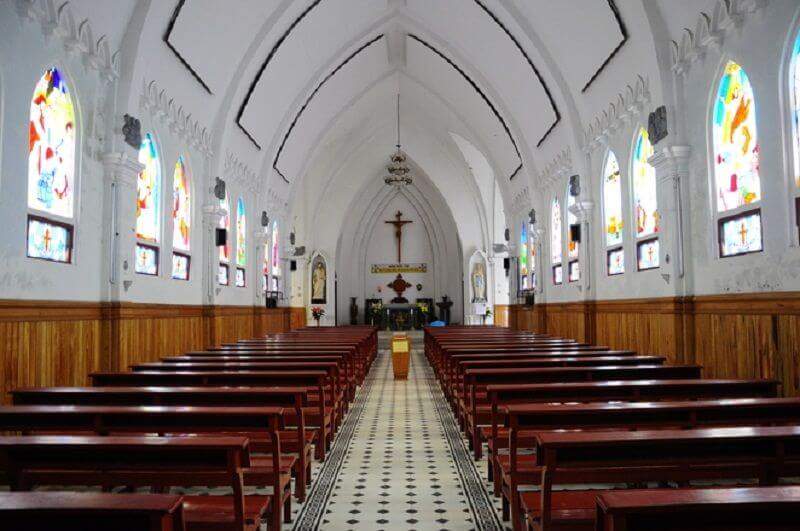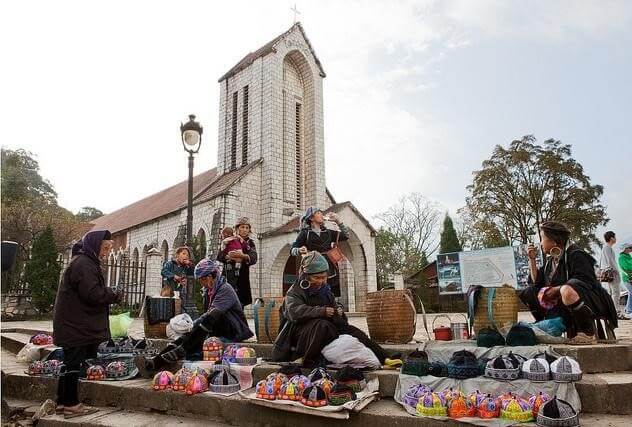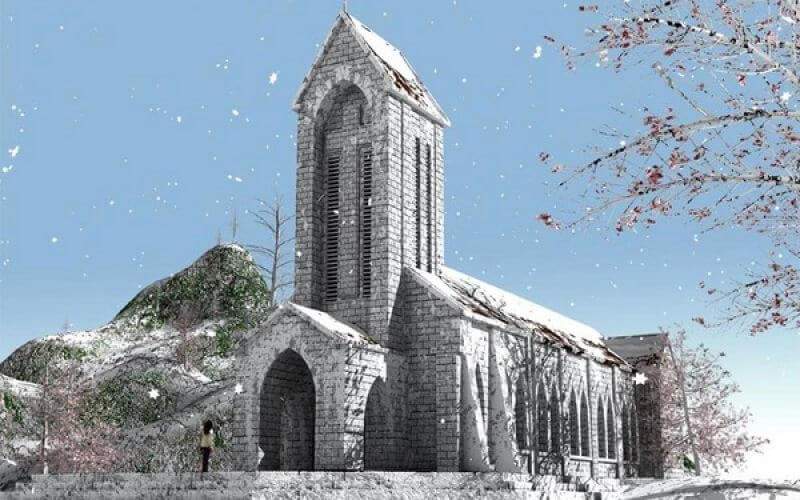In the northern part of Vietnam, akin to the charm of Dalat in the south, lies Sapa—a city blessed with a year-round cool climate and numerous famous landscapes. Among these, the Sapa Stone Church stands out. In this article, let’s explore the unique features that make this destination captivating!
Sapa Stone Church – Unique Architectural Masterpiece in Lao Cai

Sapa stone church (collectibles photo)
The construction of Sapa Stone Church dates back to the early 20th century, around 1935. This magnificent structure is the only remaining French architectural relic on this misty land. Over nearly a century, the church has undergone several renovations, facing the challenges of weather, history, and war. Renovating while preserving the original values of the site has been a significant undertaking.
Situated behind Ham Rong Mountain, relatively close to other scenic spots, Sapa Stone Church covers an area of 6000m2, comprising seven sections and a bell tower that reaches 20m in height. The bell tower houses a bell weighing half a ton.
The most attractive aspect of this church is its ancient Gothic-Romanesque architecture, designed by the French. Constructed entirely from local materials such as carved stone, it exudes an elegant and sophisticated charm. The spacious front yard often serves as a gathering place for buying and selling activities.
Today, the church primarily serves as a religious gathering place for the local community. If you visit on Saturdays, you may encounter a love market where young H’mong children sing hymns, showcasing the distinctive cultural identity of the area.
Unique Features of Sapa Stone Church
Orientation and Design:
Sapa Stone Church faces east, symbolizing the reception of positive energy from God to the people. The church’s architectural details contribute to its sacredness and venerable status.

Inside the stone church (photo collection)
Gothic-Romanesque Architecture:
True to its name, the church is constructed entirely from stone, with additional elements like bells, floors, and towers bonded with lime and molasses. Covering an area of over 6000 square meters, the church includes various functional rooms within its structure. Stepping through the main entrance, visitors are often overwhelmed by the dazzling design reminiscent of glorious European Gothic-Romanesque architecture, a prevalent style in 16th-century Europe. The distinctive feature of this architectural style is the cruciform shape, resembling ancient Roman crucifixes.
Unique Paint Color:
Painted entirely in white, Sapa Stone Church exudes a sense of spaciousness and openness. The church’s walls on both sides are protected by wooden cladding to enhance durability. Additionally, colorful stickers applied to the crescent-shaped glass windows create a diverse range of colors, adding to the unique characteristics of ancient European architecture.
Elegant Vaulted Ceiling:
The vaulted ceiling of Sapa Stone Church is a focal point for many visitors. Choosing red roof tiles and triangular-shaped roofing with simple, straight-line edges creates the distinctive beauty of this ancient church. The ceiling is made from straw and has been continuously maintained and repaired.

Busy business photos in front of stone churches (collectibles)
In front of the church is a large yard where ethnic people often gather to buy and sell. Inside is a church with 32 stained-glass windows, drawing pictures of the mysteries of the rosary, the Saints, and the way of the Cross.
Best Time to Visit Sapa Stone Church
With its mystical beauty, Sapa Stone Church attracts countless travelers who wonder about the ideal time to explore its charm. Many visitors question when is the best time to experience its beauty to the fullest.
Travel Time from January to April
During the early spring months from January to April, when nature is in full bloom, Sapa echoes with birds chirping, shedding the winter coat. This period, especially after the Tet holiday, is when many visit Sapa to celebrate the spring. It’s also the peak tourist season, allowing you to enjoy festival vibes with vibrant mountain markets.
Travel Time from May to July
Summer, often a leisure period for families with school holidays, becomes an ideal time to visit Sapa to escape the heat. The summer sun intermittently illuminates the ancient stone church, creating a peaceful atmosphere.
Travel Time from August to October
Visiting Sapa around August to October offers the chance to witness the golden colors of ripening rice covering the Northwest terraced fields. This period provides the clearest views of the Northwest with lively activities.
Travel Time from November to January
The coldest period in Sapa is adorned with white snowflakes. Sapa Stone Church is covered in a white blanket during winter, accentuating its mystical allure. The entire landscape turns mysterious, creating a cold but enchanting atmosphere.

Sapa stone church in snow season (photo collection)
Impressive Grounds to Explore
With a sprawling area of 6000 square meters, the complex is divided into various distinct zones: the church area, the living quarters for the priests, the livestock area, the angel house, the front yard, the fence, and the Holy Garden. The row of dwellings runs parallel to the church area, comprising five sections.
The angel house features a basement and three upper floors, serving as a place for healing the sick, welcoming travelers, housing facilities, and a kitchen.
The Holy Garden boasts two mausoleums with five ancient Khao Vang trees, including four trees growing on rocky cliffs.
The 7-section church area covers a vast space of 500 square meters, with a bell tower standing tall at about 20 meters. Inside the tower, there is a bell measuring 1.5 meters in height and weighing 500 kilograms, cast in 1932. Its resonating sound can reach up to a radius of 1 km. The bell’s surface contains inscriptions related to its history, and the bell stand is crafted from durable Pơmu wood, remaining remarkably intact.
Additionally, you’ll find other intriguing areas like the front yard, where cultural and religious activities take place. It serves as a hub for cultural exchanges and souvenir trading. Every Saturday, the famous Love Market in Sapa hosts lively cultural and commercial activities that are truly captivating.
Ideal Check-In Spots
Panoramic View of the Church
The church boasts a stunning space, providing the perfect opportunity to capture a complete shot of the church and yourself. The harmonious combination ensures you’ll be pleased with this snapshot.
Church Combined with Sapa Square
Most tourists will be intrigued to capture more of nature in this space.
The Staircases
Due to its proximity to the central square, the church is connected by upward staircases. Sitting on the steps and capturing the scene with the church will give you a beautiful photo. This photography style always produces a very subtle vintage-like aesthetic without being ‘interrupted’ by too many people in the frame.
The Church Illuminated at Night
As dusk falls, the various colored LED lights envelop the church, creating a warm and romantic atmosphere. This setting, illuminated in the evening, adds a touch of charm to the space.
Tips for a Memorable Trip to Sapa Stone Church
For those planning to visit Sapa Stone Church, here are some travel tips to ensure a comfortable experience and create beautiful memories:
- – Cash: Avoid carrying too much cash, as most restaurants and services around Sapa accept electronic payments.
- – Footwear: Bring comfortable sneakers alongside stylish shoes for days with extensive walking.
- – Clothing: Pack warm clothes, as Sapa is generally cold, especially at night.
- – Identification: Carry essential documents such as a driver’s license and ID card.
- – Snacks: Bring snacks and drinks of your preference, as prices for these items in Sapa can be relatively high.
Exploring Sapa Stone Church is a journey into history and architecture and an opportunity to immerse yourself in the tranquil beauty of Sapa’s misty mountains.
